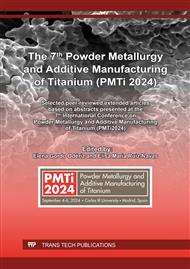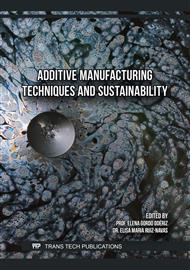[1]
R.R. Boyer, Attributes, Characteristics, and Applications of Titanium and its Alloys The Journal of the Minerals, Metals and Materials Society. 62 (2010) 21-24.
Google Scholar
[2]
H. Kudo, K. Iwano, and J. Nishino, Cementless or Hybrid Total Elbow Arthroplasty with Titanium-alloy Implants : A Study of Interim Clinical Results and Specific Complications,The Journal of Arthroplasty. 9 no. 3, (1994) 269-278.
DOI: 10.1016/0883-5403(94)90081-7
Google Scholar
[3]
W. Wang and C. K. Poh, Titanium Alloys in Orthopaedics,in: J. Sieniawski and W. Ziaja (Eds.), Titanium Alloys - Advances in Properties Control, IntechOpen, 2013, pp.1-19.
DOI: 10.5772/56197
Google Scholar
[4]
A. Illarionov, S. Belikov, S. Grib, and A. Yurovskikh, Metallic Materials for Medical Use, in XIII International Scientific -Technical Conference "Dynamic of Technical Systems", 2017, vol. 132, no. MATEC Web Conf.
DOI: 10.1051/matecconf/201713203003
Google Scholar
[5]
K. T. Kim, M. Y. Eo, T. T. H. Nguyen, and S. M. Kim, General Review of Titanium Toxicity,International Journal of Implant Dentistry. 5 (2019) 1-12.
DOI: 10.1186/s40729-019-0162-x
Google Scholar
[6]
R. M. Diaz-Sanchez, A. Paz-Carrion, M. A. Serrera-Figallo, D. Torres-Lagares, A. Barranco, J. R. Leon-Ramos, and J. L. Gutierrez-Perez, In Vitro and In Vivo Study of Titanium Grade IV and Titanium Grade V Implants with Different Surface Treatments,MDPI Metals 10 (2020) 1-14, doi:.
DOI: 10.3390/met10040449
Google Scholar
[7]
M. H. Wu, M. H. Lee, C. Wu, P. I. Tsai, W. B. Hsu, S. I. Huang, T. H. Lin, K. Y. Yang, C. Y. Chen, S. H. Chen, C. Y. Lee, T. J. Huang, F. H. Tsau, and Y. Y. Li, In Vitro and In Vivo Comparison of Bone Growth Characteristics in Additive-Manufactured Porous Titanium, Nonporous Titanium, and Porous Tantalum Interbody Cages MDPI Materials. 15 (2022) 1-20.
DOI: 10.3390/ma15103670
Google Scholar
[8]
A. Nouri, P.D. Hodgson, and C. Wen, Biomimetic Porous Titanium Scaffolds for Orthopedic and Dental Applications,in: A. Mukherjee Ed., Biomimetics Learning from Nature, IntechOpen, 2010, pp.415-450.
DOI: 10.5772/8787
Google Scholar
[9]
Y. Li, Y. Xiao, and C. Liu, The Horizon of Materiobiology: A Perspective on Material-Guided Cell Behaviors and Tissue Engineering,Chemical Reviews. 117 no. 5, (2017) 4376-4421.
DOI: 10.1021/acs.chemrev.6b00654
Google Scholar
[10]
M.L. Raffa, V.H. Nguyen, P. Hernigou, C. H. Flouzat-Lachaniette, and G. Haiat, Stress Shielding at the Bone-Implant Interface: Influence of Surface Roughness and of the Bone-Implant Contact Ratio Journal of Orthopaedic Research. 39 no. 6, (2020) 1174-1183.
DOI: 10.1002/jor.24840
Google Scholar
[11]
I.-H. Oh, N. Nomura, and S. Hanada, Microstructures and Mechanical Properties of Porous Titanium Compacts Prepared by Powder Sintering,Materials Transactions. 43 no. 3, (2002) 443-446.
DOI: 10.2320/matertrans.43.443
Google Scholar
[12]
C. Xiang, Y. Zhang, Z. Li, H. Zhang, Y. Huang, and H. Tang, Preparation and Compressive Behavior of Porous Titanium Prepared by Space Holder Sintering Process,Procedia Engineering. 27 (2012) 768-774.
DOI: 10.1016/j.proeng.2011.12.518
Google Scholar
[13]
T. Sanchez, A. Mushref, M. Norrito, K. Yendall, Y. Liu, and P. Conway, The Effect of Pore Size and Porosity on Mechanical Properties and Biological Response of Porous Titanium Scaffolds,Materials Science and Engineering C. 77 (2017) 219-228.
DOI: 10.1016/j.msec.2017.03.249
Google Scholar
[14]
Y. Torres, S. Lascano, J. Bris, J. Pavon, and J. Rodriguez, Development of Porous Titanium for Biomedical Applications: A Comparison between Loose Sintering and Space-Holder Techniques Materials Science and Engineering C. 37 (2012) 148-155.
DOI: 10.1016/j.msec.2013.11.036
Google Scholar
[15]
S. Lascano, C. Arevalo, I. Montealegre-Melendez, S. Munoz, J. A. Rodriguez-Ortiz, P. Trueba, and Y. Torres, Porous Titanium for Biomedical Applications: Evaluation of the Conventional Powder Metallurgy Frontier and Space-Holder Technique MDPI Applied Sciences. 9 no. 5, (2019) 1-13.
DOI: 10.3390/app9050982
Google Scholar
[16]
B. Ye and D.C. Dunand, Titanium Foams Produced by Solid-State Replication of NaCl Powders Materials Science and Engineering A. 528 (2010) 691-697.
DOI: 10.1016/j.msea.2010.09.054
Google Scholar
[17]
J. Jia, A. Siddiq, and A. Kennedy, Porous Titanium Manufactured by a Novel Powder Tapping Method using Spherical Salt Bead Space Holders: Characterisation and Mechanical Properties,Journal of the Mechanical Behavior of Biomedical Materials. 48 (2015) 229-240.
DOI: 10.1016/j.jmbbm.2015.04.018
Google Scholar
[18]
J.P. Zheng, L. J. Chen, D. Y. Chen, C. S. Shao, M. F. Yi, and B. Zhang, Effects of Pore Size and Porosity of Surface-Modified Porous Titanium Implants on Bone Tissue Ingrowth Transactions of the Nonferrous Metals Society of China. 29 no. 12, (2019) 2534-2545.
DOI: 10.1016/s1003-6326(19)65161-7
Google Scholar
[19]
Y. Chen, J. E. Frith, A. Dehghan-Manshadi, D. Kent, M. Bermingham, and M. Dargusch, Biocompatible Porous Titanium Scaffolds Produced using a Novel Space Holder Technique,Journal of Biomedical Materials Research 106 no. 8, (2017) 2796-2806.
DOI: 10.1002/jbm.b.34060
Google Scholar
[20]
A. Civantos, M. Giner, P. Trueba, S. Lascano, M. J. M. Garcia, C. Arevalo, M. A. Vazquez, J. P. Allain, and Y. Torres, In Vitro Bone Cell Behavior on Porous Titanium Samples: Influence of Porosity by Loose Sintering and Space Holder Techniques,MDPI Metals. 10 no. 5, (2020) 1-20.
DOI: 10.3390/met10050696
Google Scholar
[21]
B. Dabrowski, W. Swieszkowski, D. Godlinski, and K. Kurzydlowski, Highly Porous Titanium Scaffolds for Orthopaedic Applications Journal of Biomedical Materials Research. 95B no. 1, (2010) 53-61.
DOI: 10.1002/jbm.b.31682
Google Scholar
[22]
I.M. Robertson and G.B. Schaffer, Some Effects of Particle Size on the Sintering of Titanium and a Master Sintering Curve Model,Metallurgical and Materials Transactions A. 40 (2009) 1968-1979.
DOI: 10.1007/s11661-009-9894-1
Google Scholar
[23]
D. P. Barbis, R. M. Gasior, and G. P. Walker, Titanium Powders from the Hydride-Dehydride Process,in: M. Qian and F. H. Froes (Eds.), Titanium Powder Metallurgy: Science, Technology and Applications Butterworth-Heinemann, 2015, ch. 7, pp.101-116.
DOI: 10.1016/b978-0-12-800054-0.00007-1
Google Scholar
[24]
Standard Specification for Titanium and Titanium Alloy Strip, Sheet, Plate, ASTM-B265-08, A. International, Pennsylvania, USA, 2008.
Google Scholar
[25]
H. Conrad, Effect of Interstitial Solutes on the Strength and Ductility of Titanium,Progress in Materials Science. 26 no. 2, (1981) 123-403.
DOI: 10.1016/0079-6425(81)90001-3
Google Scholar
[26]
S. Dong, B. Wang, Y. Song, G. Ma, H. Xu, D. Savvakin, and O. Ivasishin, Comparative Study on Cold Compaction Behavior of TiH2 Powder and HDH-Ti Powder,Hindawi: Advances in Materials Science and Engineering. 2021 (2021) 1-15.
DOI: 10.1155/2021/9999541
Google Scholar
[27]
S.J. Gerdemann and P. D. Jablonski, Compaction of Titanium Powders,Metallurgical and Materials Transactions A. 42A (2010) 1325-1333.
DOI: 10.1007/s11661-010-0520-z
Google Scholar
[28]
P.G. Esteban, E. Baril, Y. Thomas, and E. Ruiz-Navas, Study of Compaction and Ejection of Hydrided-Dehydrided Titanium Powder Metals and Materials International 17 (2011) 45-55.
DOI: 10.1007/s12540-011-0207-z
Google Scholar
[29]
Standard Test Methods for Density of Compacted or Sintered Powder Metallurgy (PM) Products Using Archimedes' Principle, B962-23, A. International, USA, 2023.
DOI: 10.1520/b0962-14
Google Scholar
[30]
R.M. German, Measurement Tools and Experimental Observations,in, Sintering: From Empirical Observations to Scientific Principles. USA, Butterworth-Heinemann, 2014.
DOI: 10.1016/b978-0-12-401682-8.00004-5
Google Scholar
[31]
Standard Test Methods of Compression Testing of Metallic Materials at Room Temperature E9-89a, A. International, USA, 2000.
Google Scholar
[32]
R. German, Geometric Trajectories During Sintering,in: 1st ed., Sintering : From Empirical Observations to Scientific Principles. MA, USA, Butterworth-Heinemann : Elsevier, 2014, pp.141-179.
DOI: 10.1016/b978-0-12-401682-8.00006-9
Google Scholar
[33]
A. Rodriguez-Contreras, M. Punset, J. A. Calero, F. J. Gil, E. Ruperez, and J. M. Manero, Powder Metallurgy with Space Holder for Porous Titanium Implants: A Review,Journal of Materials Science & Technology. 76 (2021) 129-149.
DOI: 10.1016/j.jmst.2020.11.005
Google Scholar
[34]
C. Ohman-Magi, O. Holub, D. Wu, R. M. Hall, and C. Persson, Density and Mechanical Properties of Vertebral Trabecular Bone-A Review,JOR Spine. 4 (2021) 1-15.
DOI: 10.1002/jsp2.1176
Google Scholar
[35]
E. Lakatos, L. Magyar, and I. Bojtar, Material Properties of the Mandibular Trabecular Bone,Hindawi: Journal of Medical Engineering. 2014 (2014) 1-8.
DOI: 10.1155/2014/470539
Google Scholar
[36]
M. Steytler, The Commercial Viability of Direct Powder Rolled Titanium: A Systematic Review and Market Analysis Masters Degree, Centre for Materials Engineering, University of Cape Town, 2018.
DOI: 10.3390/ma13092124
Google Scholar



